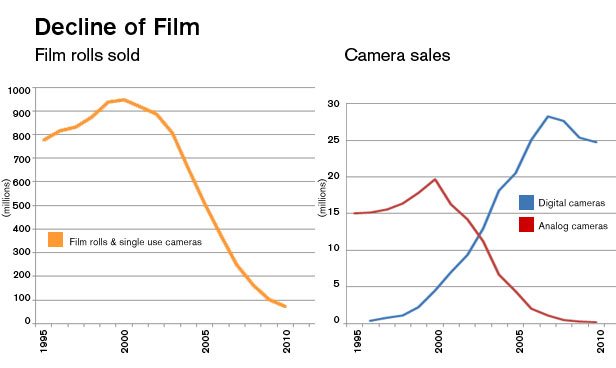The 5 technological revolutions

The world is changing rapidly. The cause must mainly be attributed to the rapid advance of technology. Throughout history, there have been many companies that were unwilling or unable to imagine the changing zeitgeist, resulting in bankruptcies. At the same time, there has been a global process of progress. In this blog post, I explain more about the different technology revolutions and what impact they have had on the world, based on Carlota Perez‘s research.
Despite many people denying it, there is indeed structural progress in the world. However, good and bad times alternate. There have been five major technological revolutions in the past 250 years. The most recent was in 1971, when Intel introduced the ‘computer on a chip’. It was the first microchip that, because of its low production cost, boosted the development of microelectronics. This is what the microchip looked like:

There have been four previous technological revolutions in history.
1 – 1771 – Era of industrial revolution
2 – 1829 – Era of steam engines and railways
3 – 1875 – Era of steel, electricity and heavy industry
4 – 1908 – Era of oil, automobile and mass production
5 – 1971 – Era of information and communication
Every revolution starts with a breakthrough innovation with enormous impact. Indeed, the Intel chip can be compared to the cotton mill in 1771, or the invention of the steam locomotive presented in 1829. You can also consider the first steel mill in 1875 as a driver of the third revolution. For the fourth technological revolution, you can look at the introduction of the T-Ford, which is one of the first cars to be mass-produced. First produced in Detroit in 1908, the car looked like this:

Every time a breakthrough innovation is released, you can think of it as the emergence phase of a revolution. This phase allows companies to adopt new technology cost-competitively. When they start doing so, the hype phase enters. This is when unrealistically high expectations arise. There is then often technological euphoria and financial speculation, leading to a bubble in the stock market.
Despite all the turbulence, eventually the new technology wins the battle from the old. You see polarisation between new and mature technologies, modern and obsolete companies and people with old and new skills.
You also see countries rearranging themselves differently and new technological developments affecting income distribution. This becomes highly unequal, leading to many protests. If they bubble then bursts, a recession or even a depression may follow, in which the financial market calms down. As in the dot-com bubble in the US during the fifth technological revolution, depicted below:

The moment of the bursting of a bubble is a so-called turning point. This is the time when the roll-out of a technology begins, when society adapts to it and the potential of the technological revolution comes to fruition. The first phase of this new period is called a synergy phase. Then the technological revolution ends with a maturity phase in which the increasing power of new technology declines. Each technological revolution lasts about 40 to 60 years and thus consists of four phases. Those phases are shown graphically below:

We are currently some time past the turning point of the fifth technological revolution (after the dot-com crash). The result of every technological revolution is that progress reaches a higher level. The first revolution created the first industrial companies bringing products to the market that met our physiological human needs (such as clothing and housing). The last technological revolution brought us a virtual space that allows us to communicate with each other (PC and the internet) and give more substance to our daily activities. Every technological revolution causes a structural change/improvement that simultaneously redistributes power in society. The question now is when the next technological revolution will happen. These are the revolutions we have seen so far with their corresponding corrective crises:

Many companies have also experienced the changes of a technological revolution first hand. Many companies think in terms of the business operations that have been successful in the past and do not know enough about alternative scenarios. An example of a company that failed to adapt in time is Kodak.
Kodak was the first company to develop the photo camera. But the company did not want to introduce it because sales of traditional rolls of film could be jeopardised. Other companies did not know this consideration and introduced cameras based on the new technology. When Kodak also entered the digital camera market, it was too late. The company went bankrupt in 2012, even though it had 140,000 employees in 1996 and the company was worth $28 billion on the stock market at the time:

The example of Kodak shows that a well-established company will not be judged differently in a new technological environment. With the emergence of a new technology, organisations should constantly examine which developments could be of interest to them. Scenarios must then be drawn up in which the breakthrough technology is leading.
Adaptive organising starts with recognising the nature of the technological revolution and that phase it is in. If there is a misfit of the organisation with the world around it, the company or institution soon finds itself in difficult waters, as it will no longer be ‘of its time’.
Those who experience the future as a headwind are walking in the wrong direction – Martin Held
In my upcoming blog post, I will explain how companies can organise themselves adaptively. As society is in the mature phase of the fifth technological revolution, it gives me an excellent opportunity to write about the opportunities and challenges of technological developments in the next decade. Hopefully, you will be there when my next article is published. I’ll see you then! 😉








[…] niet allemaal in één keer gebeurd. Vaak gaat het in kleine stapjes tegelijk. Toch zijn er enkele technologische revoluties geweest in de geschiedenis. Dit zijn erg belangrijke momenten geweest in de ontwikkelingen van de […]